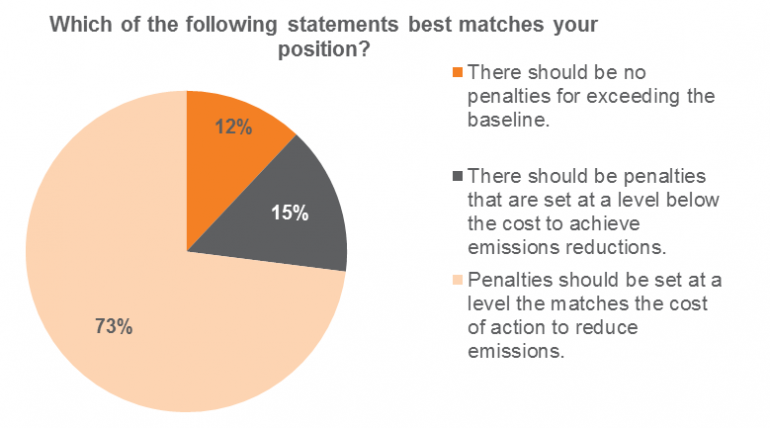Listening to the market
*This is part two of a five-part series from Energetics. For part one, click here.
In this second article on the Emissions Reduction Fund, Energetics reports on the feedback received from a survey of some of Australia’s largest energy users, as well as the poll results from our Direct Action webinar series. More than 20 senior business representatives with responsibilities for energy and carbon management participated in a survey assessing their design preferences across key aspects of the government’s Emissions Reduction Fund.
The questions covered five major design issues:
– the type of baseline to be applied
– penalties and how they will be imposed
– voluntary versus mandatory participation in the Fund
– types of emissions reduction projects that should be allowed into the Fund auction process
– the timing of funding awarded, and the use of revenues raised through the operation of the Fund.
In this week before submissions responding to the terms of reference for the Emissions Reduction Fund are due, common concerns and clear design preferences are emerging.
Creating a fair and equitable market place – Australian business believes in a fair go
The overwhelming feedback shows that business favours a scheme that is equitable, even if it results in a degree of complexity. Australian companies believe in a ‘fair go’ and look for certainty to conduct business. This informs their view on climate policy.
Our polling is showing that business is prepared to accept appropriate penalties imposed for underperforming businesses, provided there is a level playing field. There is also a clear message that the level of penalties should be determined by a market-based mechanism, and that funds raised from the levying of penalties for exceeding the baseline should be recycled back to support all forms of abatement activities.
Figure 1: Direct Action survey feedback

What is the basis for baselines?
Businesses welcome the use of the existing National Greenhouse and Energy Reporting scheme to provide the underlying information source as it removes the need to develop new systems which is a common complaint associated with the rollout of new legislation.
A major issue for the government to address will be how a Direct Action baseline accounts for different business activities. Baselines can be set at a site, facility, industry or company level. They can be based on emissions intensity or absolute emissions. Each of these approaches will come with a unique set of issues, and a hostile group of stakeholders, that the new Government will have to manage.
Corporations with diversified business interests argue against company-specific baselines as not being representative of the diversity in business activity. Industry or sectoral baselines don’t account for the huge variances in emissions across operations such as we see in the coal sector. Facility and site level baselines are likely to be the most representative, but will be difficult to establish and manage due to the number needed.
To manage uncertainty, the government will need to provide clarity around how baselines account for changes in operating conditions and business structures. How a baseline accounts for variations is particularly important when considering the growth and expansion in operations.
The Direct Action plan proposes that baselines will be adjusted to reflect changes in production. Across the briefings held, this principle was well-received with strong support for site-specific baselines.
The support for this approach suggests that businesses want to see baselines derived from emissions intensity rather than absolute emissions levels, and that the emissions intensities used to determine the baselines should be site-specific where possible. If designed correctly, intensity based emissions baselines can create a level playing field. Although, concern was expressed by industry as to how a baseline can be set for a new entrant where there is no existing site intensity factor.
Penalties and business support for penalties that match cost of emissions reduction
Penalties have received little discussion. The Direct Action plan speaks of penalties for businesses that produce emissions above their ‘business as usual’ levels. Yet there is limited information available on the type, form and extent of penalties. Surveyed businesses overwhelmingly (73 per cent) indicated that penalties should be set at a level that matches the cost of efforts to reduce emissions. However, are penalties necessary for an equitable market place? Business seems to think so.
Figure 2: business feedback on the application of penalties

In keeping with building an equitable, market-based approach to climate change policy in Australia, business would like to see Direct Action penalise companies that exceed their baselines provided it is done fairly. Penalties provide the necessary signal to drive behavioural change. For maximum impact, the level of penalties should be derived from a market-based mechanism that also sets the penalties at a level comparable to the cost of abatement.
*The next two parts of Energetics’ series on Direct Action will explore the specific design aspects of the Emissions Reduction Fund based on this industry feedback.
Emma Fagan is a consultant and Dr Peter Holt and Gordon Weiss are both principal consultants with Energetics.
















